Ali Sooodeh1, Reza Ansari2, HashimBin Abdul Razak2, Emad Kasra Kermanshahi3
1Department of Mechanical and Manufactory Engineering, Universiti Putra Malaysia
2Department of Civil Engineering, University of Malaya
3Department of Civil Engineering, Universiti Teknology Malaysia
Correspondence to: Ali Sooodeh, Department of Mechanical and Manufactory Engineering, Universiti Putra Malaysia.
| Email: |  |
Copyright © 2015 Scientific & Academic Publishing. All Rights Reserved.
Abstract
Energy usage is an issue at any institution due to increasing use because of population increase as well as increase in energy cost. The engineering faculty of UPM has a high usage of energy consumption. This study is concerned with determining energy use and losses at department of mechanical and manufacturing engineering of UPM at available energy consumption and potential of energy saving at this faculty. The methodology involves determining power consumption per floor and based on number of lights, personal computers and printers in each room. After that, the possible generation of solar energy from PV is measured together with its potential return of investment. Results show that current building`s energy index is 176.2 kwh/m2 which is high.
Keywords:
Electricity Consumption, Solar Panel, Environment, Renewable Energy, Saving Energy
Cite this paper: Ali Sooodeh, Reza Ansari, HashimBin Abdul Razak, Emad Kasra Kermanshahi, Total Quality Energy Management of Kmp Universiti Putra Malaysia, International Journal of Tumor Therapy, Vol. 4 No. 1A, 2015, pp. 22-29. doi: 10.5923/c.ijtt.201501.04.
1. Introduction
In the recent decades, energy researchers have shifted their focus from fossil fuels to renewable energy and particularly focused on solar energy. Various technologies have attempted to use solar systems in buildings to generate the required electricity and heat [1]. Solar systems will produce energy by absorbing sunlight and transforming it to heat and electricity. Solar technology (system) can be classified into the passive and active systems [2]. Commercial greenhouse is an example of a passive solar building.A greenhouse provides its required energy by solar technology. To be more specific, greenhouse which is a Structure roofed by a transparent cover such as glass absorbs sunlight and converts it to heat and electricity while controlling the temperature ([3], [4]).An illuminated PV cell transforms merely a small portion of the sunlight into electrical energy [5]. The rest of the sunlight is transformed into heat, which leads to the heating of the cell. Consequently, the cell functions above Ambient temperature. Maintaining insolation level as steady, whenever the temperature increases ([6] [7]).Table 1. Types of Generate Electricity Include Advantages and Disadvantages
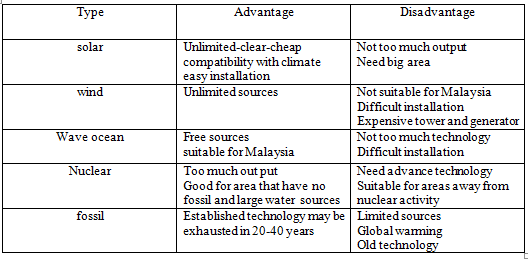 |
| |
|
Nowadays, energy production has become a global concern in all over the world. Global reliance on fossil fuels as the major sources of energy production caused several problems that can be discussed in two levels. The first level is that fossil fuels are finite sources of energy production. Therefore, they are limited and global concerns are increasing for providing sufficient energy. On the second level, energy and particularly electricity produced by fossil fuels is not a clean energy. Due to the high CO2 emission of fossil fuels, scientists have attempted to replace fossil fuels by renewable forms of energy that are infinite and clean. In this case, human can access to abundant amount of energy that is renewable and has zero carbon-footprint. Solar energy is one such forms of renewable energy that is a suitable replacement for fossil fuels particularly in countries that has abundant access to sun beam and sun exposure such as Malaysia. Such countries should tackle the problem of pollution caused by using fossil fuels and concerns about electricity shortage by using solar energy as a replacement for fossil fuels. In this case it is essential to find out the suitable kind and number of solar panels for generating particular amount of electricity especially in the organizations with high amount of electricity usage such as Universiti Putra Malaysia. Universiti Putra Malaysia is an area of 1108.103 hectares has since enclosed the panoramic view of nature. Various facilities are offered for the comfort of the students and staff common facilities for all students such as library class rooms, gym, examination halls, playground, swimming pool, stadium, food court and etc. and also there are specific facilities for different disciplines, such as laboratory, speech lab, computer lab and etc., where whole of these places and facilities need electricity. Air-conditioning and ventilation is necessary to facilitate learning but air-condition has big rate of electricity consumption. The electricity consumption is not just for ventilation but also lights, electric devices, computers, projectors, machines and plug loads. The average of electricity cost of Universiti Putra Malaysia is three million ringgit per month that is huge amount of money. As the used electricity for UPM is produced by fossil fuels, it is crucial to reduce the amount of required energy. Furthermore, we believe that the electricity should be generated with solar panels to have clean and unlimited amount of energy and to produce electricity with cheaper cost. Thus there is a need to identify simple means and methods that can help reduced energy usage and replacing the systems of energy production [8].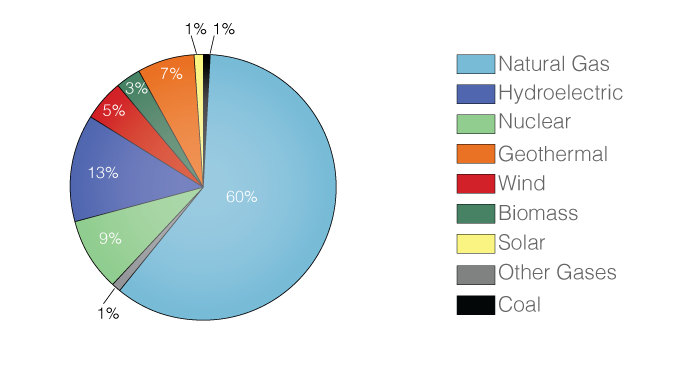 | Figure 1. Types of Electricity Generate |
1.1. Objective of Paper
1. To calculate potential energy generation from solar panels.2. To calculate the number of solar panels according to temperature and radiation of each month.
2. Literature Review
Types of Solar PanelGenerally, solar technology consists of two main categories solar photo-voltaic (PV), and modules and concentrating solar power (CSP). The following sections will briefly define these two major categories of solar technology.
2.1. Photo-Votic (PV) Method
The basic building block of the PV devices is a semiconductor element called PV cell. PV cell transforms solar energy into direct current electricity. It transforms sunlight energy into electrical energy. PV cell functions by absorbing photons from the sunlight. In this process atoms transfer from the lower orbit to higher orbit and consequently leave the parent atoms. In the current market, four common families of photovoltaic (PV) modules are available which are mono-crystalline silicon, polycrystalline- line silicon, hybrid and thin film. The cells in a mono-crystalline module are made from a single silicon crystal [9].
2.1.1. Mono Crystalline Panels
Mono crystalline panels consist of solar cells, which are slices cut from pure drawn crystalline silicon bars. In this panel, the whole cell is arranged and positioned in one direction. This unidirectional alignment causes extreme efficiency in mono crystalline panels when the sun is shining brightly on the cell at the correct angle. In other words, mono crystalline panels operate best in the direct exposure of bright sunlight. It means that their performance and efficiency is higher when the sunlight is direct and bright. In order to absorb sunlight better, mono crystalline panels have a uniform blacker color [10].
2.1.2. Poly Crystalline Panels (multi crystalline)
Polycrystalline panels consist of the silicon offcuts, shaped to produce blocks and a cell consist of several bits of pure crystal. Polycrystalline panels are not highly efficient as in these panels individual crystals are not perfectly arranged and aligned together. Due to this imperfect alignment, losses at the joints between crystals are inevitable which make the panel almost inefficient. However, this alignment is appropriate for some situations, as the cells operate better in light at all angles, and even in low light [11].
2.1.3. Hybrid Panels
The chief producer of hybrid panels is Panasonic Company. Panasonic’s HIT hybrid panels’ module has a thin layer of amorphous solar film behind the mono crystalline cells. The extra amorphous layer obtains and absorbs higher amounts of energy from the available sunlight, especially in low light circumstances. Hybrid panels are considered as the most efficient panels available, and they occupy the least space on the roof [12].
2.1.4. Black Backed Panels
Unlike traditional cells, which used white backing behind the cell, Black Backed Panels use black backing behind the cell. This black covering is for appearance purposes as it gives a much better appearance to the solar panel, especially on slate roofs or old traditional cottages with dark colored plain tiles [13].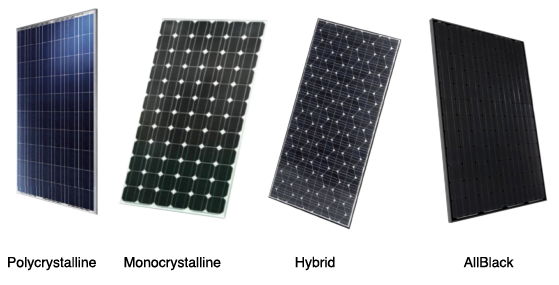 | Figure 2. Types of Solar Panels |
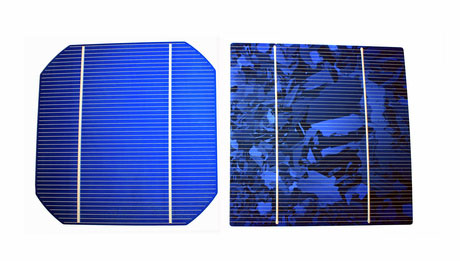 | Figure 3. Monocrystalline and polycrystalline solar cell |
2.2. Concentrated Solar Power (CSP) Method
Concentrated Solar Power (CSP) method utilizes reflective surfaces to concentrate sunlight into a beam to heat a functioning fluid in a receiver. The heat generates steam which is employed to drive the turbine and consequently to run the generator to generate power. The concentrated solar power has three categories entitled, Parabolic Trough System, Power Tower and Dish Engine System.
2.2.1. Trough Systems (Parabolic)
Trough Systems utilize large, U-shaped (parabolic) reflectors (focusing mirrors) that contain oil-filled pipes running along their center, or focal point. The mirrored reflectors are tilted toward the sun. They operate by focusing the sunlight on the pipes to heat the oil inside. The heated oil is the employed to boil water that causes steam to run traditional steam turbines and generators.
2.2.2. Tower Power System
Tower power system also known as central receivers are utilized in several large, flat heliostats (mirrors) to track the sun and concentrate its beams onto a receiver. The receiver is located on top of a tall tower where concentrated sunrays heat a liquid. The hot liquid can either be directly and instantly used to produce steam for electricity production or stored to be utilized later [14].
2.2.3. Dish Engine System
Dish engine system employs mirrored dishes, which are almost 10 times larger than backyard satellite dishes to concentrate sunlight onto a receiver. In dish engine system, the receiver is located at the central point of the dish. This position facilitates capture of solar energy and helps absorb the maximum amount incident on it. The dish assembly tracks the sun across the sky. The receiver is attached to an efficient External combustion engine. The receiver, engine, and generator composed a single, unified assembly located at the center of the mirrored dish. | Figure 4. Types of Concentrated Solar Power |
3. Methodology
To achieve the earlier mentioned objectives of the study, this paper will find out the required number of solar panels needed to generate electricity for the engineering faculty of UPM. The methodology to achieve the objectives is to collect data of electricity consumption of the faculty, radiation, and temperature three times per month for a period of 12 months (a year). During these 3 times per month of the year, the maximum, average and minimum of temperature will be used to find out the maximum, average and minimum solar panels needed to produce electricity for the faculty of engineering at UPM. The collected data will be analyzed through Matlab software in order to obtain the number of required solar panels for electricity production for each month of the year based on electricity consumption, temperature and sun radiation of the particular month. The data collection is conducted during 12 months of a year and 3 times per month to find out that how many solar panels are needed every month for providing required electricity for the engineering faculty of UPM.
3.1. Data Collection
In this paper, 3 sets of data are needed to be analyzed by Matlab software known as radiation, temperature and electricity consumption. Electricity consumption of engineering faculty is obtained by the electricity bill, while data regarding radiation and temperature are obtained through a valid article. The article that is used for collecting data of radiation and temperature values is Abdul Majeed (2013) [15]. Another important factor in this study is the type of solar panel. For selecting type of panel, the researchers communicated with a global solar company called Solar Land. Malaysia’s Solar Land Puchong branch.
4. Discussion and Result
4.1. Radiation
Solar radiation and temperature are very important data that are used for simulation and analysis in this research as both of them have effect on electricity generated by solar panel [16].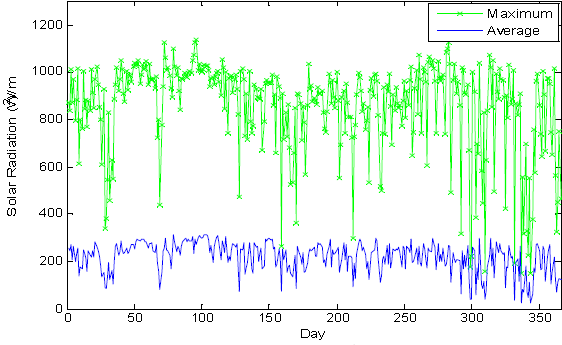 | Figure 5. Average and maximum solar radiations throughout one year |
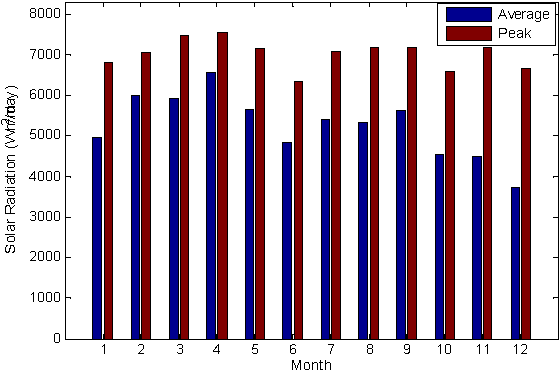 | Figure 6. The average and peak solar radiation in each month |
4.2. Temperature
Normally, in areas and countries with high sun exposure and high temperature, solar energy is more efficient. This signifies the important role of temperature in solar energy production as by the change in temperature the amount of solar energy varies. The following figures 7 and 8 illustrate the changes in temperature in Malaysia. They represent the maximum, average and minimum temperature in Malaysia during a year [17].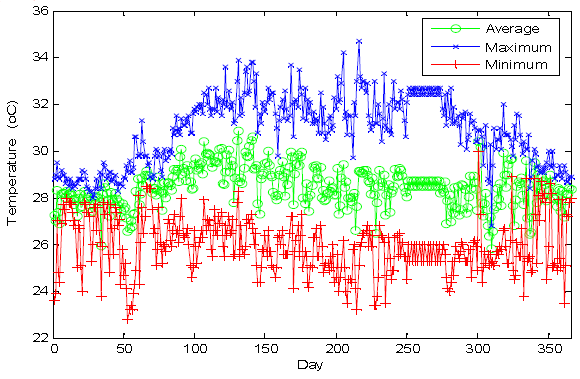 | Figure 7. The average, maximum and minimum temperature in degree for 365 days |
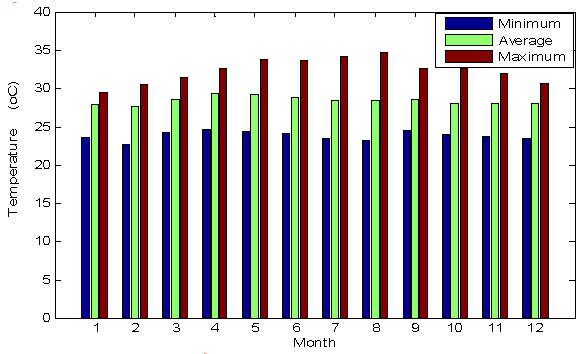 | Figure 8. Monthly minimum, maximum and average temperature for Malaysia |
4.3. Solar Panel Feature and Technical Information
As mentioned earlier, the type and characteristics of solar panel are very important elements in efficiency of solar panels. This study finds out SLP260-24 solar panel as the most suitable panel for generating electricity for engineering faculty of UPM. The electrical characteristics and specifications of this model of solar panel (SLP260-24) are presented in the following table 2. and table 3. respectively.Table 2. Electrical Characteristics of Solar Panels, which Assume in this paper
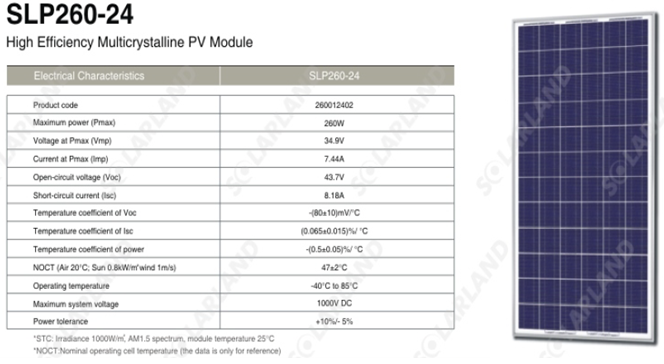 |
| |
|
Table 3. Specification of SLP260-24 Solar Panel
 |
| |
|
4.4. Tenaga Nasional Electricity Cost
Tenaga National has provided the new electricity rate for electricity bills at Malaysia. By this rate list the price of electricity usage more than 900 Kilo Watt is 57.10sen per KWH. As in this paper, the case study is faculty of engineering at UPM where the average electricity consumption is more than 900 KWH, the electricity cost is calculated by 57.10 Sen per KWH. The following table 4. presents the cost rate of electricity per KWH provided by Tenaga National. Table 4. Electricity consumption rate per kilowatt provided by TENAGA
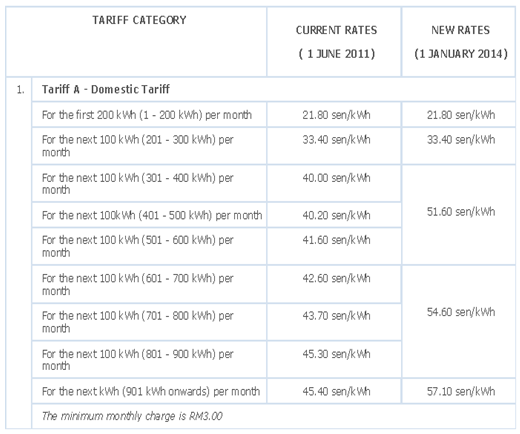 |
| |
|
The following table 5. Shows the amount of electricity consumption in engineering faculty of UPM in 2014. It presents the consumption value per month from January till December 2014. Table 5. The amount of electricity consumption of engineering faculty of UPM in 2014
 |
| |
|
Based on the cost rate (shown in the table 4.) and electricity consumption value (shown in table 5.), Tenaga National calculated the electricity bill of engineering faculty of UPM. The following figure 9. Indicates the information regarding the electricity cost of engineering faculty in 2014. The electricity cost is presented from January 2014 until December 2014.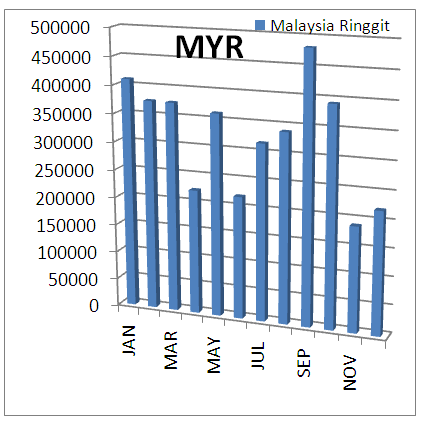 | Figure 9. Electricity Price for Each Month |
The below figures and tables show the result of changes in temperature and radiation as well as the number of solar panels required in January and May 2014. Furthermore, the area of land needed for installing solar panels to generate sufficient electricity for engineering faculty of UPM are also calculated and presented. These two months (January and May) are randomly selected for discussing the findings of this paper. Each of the above-mentioned factors (consumption, temperature and radiation) is calculated 3 times per month to find the maximum, average and minimum value of each factor. After choosing the specific solar panel model (SLP260-24), it is determined that how much area is needed to install solar panels to operate the electricity generation. The following table 6, figure 10, and figure 11 demonstrate the number of solar panels required for January as well as the area occupied for installing solar panels to produce the electricity consumed in this month (718,938 KWH). As shown, in day 3 that has maximum temperature, the number of solar panels is the minimum (n=10,276) and consequently the area of land for solar panels’ installation is the least with 20,522m2. Relatively in day 2 with the average temperature, the number of solar panels and the land for installing them is more by 14,366 solar panels and 28,732m2 of land. Finally, in day 1 with the minimum temperature, the number of required solar land is the highest (n = 19,862) and subsequently the required area for solar panels’ installation is larger with 39,762m2. Table 6. The Number of Solar Panels, Area Occupied and Electricity Consumption for January
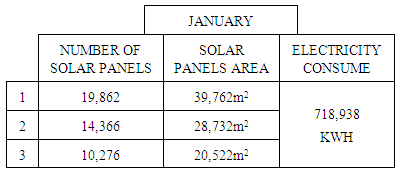 |
| |
|
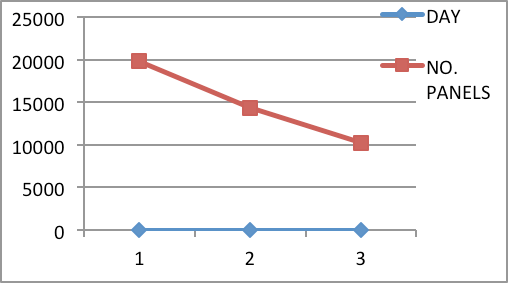 | Figure 10. The Number of Solar Panels Which Need for three days in January |
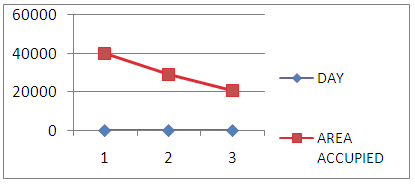 | Figure 11. The Area Occupied of Solar Panels for Three Days of January |
After presenting the finding of January in the above section, the following section will discuss the findings of the study regarding the number of solar panels required for May 2014 as well as the area occupied for installing solar panels to produce the electricity consumed in this month (633,600 KWH). As presented in the succeeding table 7, figure 12 and figure 13, in day 3 with the highest temperature, the number of needed solar panel is the lowest (n=8,427) and the required land for installing these solar panels is 16,854m2. However, in day 2 with the average temperature, the value of needed solar panel is 10,804 with 21,608m2 of land for installation. Lastly, day 1 with the lowest temperature needs the highest number of solar panels (n=17,503) and largest area for installation of solar panels with 35,006m2 to generate electricity. Table 7. The Number of Solar Panels, Area Occupied and Electricity Consumption for May
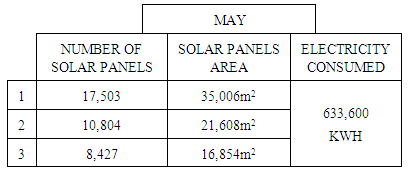 |
| |
|
 | Figure 12. The Number of Solar Panels Which need for Three Days of April |
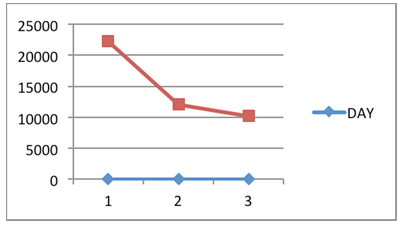 | Figure 13. The area Occupied of Solar Panels for Three Days of Apr |
The following table 8 shows the maximum and minimum number of solar panels required in all 12 months of the year from January till December 2014. Based on the table, the highest number of needed solar panel is in September with n=24,092. So, this number of solar panels should be installed in order to provide the electricity for engineering faculty of UPM. However, during other months of the year that the electricity consumption is less and the number of needed solar panel is lower, to avoid energy loss the extra solar panels can be covered or their electricity current can be cut. In this case, the sufficient amount of electricity can be produced to save energy. Table 8. Maximum and Minimum Number of Solar Panel in one Year
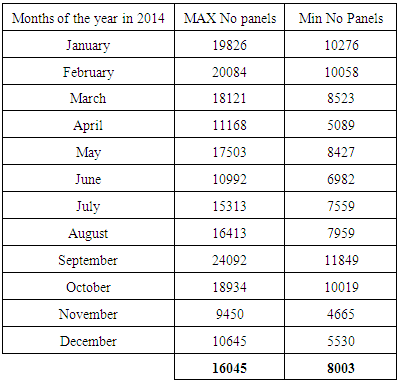 |
| |
|
The following figure 14, presents the data regarding the amount of land required for each month solar panels installation. As discussed earlier, we recommend installing 24,092 solar panels that requires 50,000m2 land. This amount of land is needed to install the maximum number of solar panels to produce the highest amount of electrify in September. 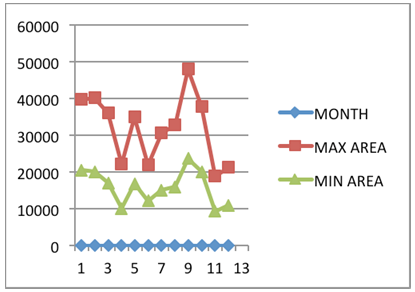 | Figure 14. Maximum and Minimum Area Occupied in one Year |
The figure number 14 show the average of whole maximum occupied are and minimum of occupied are and compare together as you can see on chart. The duration for calculates occupied are area is 12 months.
5. Conclusions
In recent years the focus on using renewable energy has become more prominent due to the political, economic and pollution problems worldwide. Among various types of renewable energy, solar energy is one of the cleanest, safest and most reliable forms of energy with low rate maintenance cost particularly for the counties with rich solar radiation. Lack of knowledge about solar system and its benefits is a big issue. This study shed lights on solar energy benefits and its practicality in faculty of engineering at UPM. In this paper, the minimum, maximum and average temperature, sun radiation and electricity consumption were considered to find out the accurate number of required solar panels for generating electricity for faculty of engineering. The findings of the paper has shown that 24,092 number of solar panels have to be installed in 50,000m2 of land in order to provide the maximum amount of electricity needed for engineering faculty in September. It is further argued that, for other months of the year with lower consumption rates, either extra panels can be covered or their electricity current can be cut in order to save energy and avoid energy loss.
References
| [1] | Vadiee, Amir, and Viktoria Martin. "Energy analysis and thermoeconomic assessment of the closed greenhouse–The largest commercial solar building."Applied Energy 102 (2013): 1256-1266. |
| [2] | Caicedo, David, and Ashish Pandharipande. "Daylight estimation in a faulty light sensor system for lighting control." Information Fusion (FUSION), 2013 16th International Conference on. IEEE, 2013. |
| [3] | Dahlquist, Erik, Erik Wallin, and Björn Karlsson. "A fossil fuel free Europe need new incentives and a better control to balance power production and demand."SAUPEC 2011 July 13-15 at Cape Town University, South Africa. Cape Town University. Press, 2011. |
| [4] | Sahay, Amit, et al. "A review of solar photovoltaic panel cooling systems with special reference to Ground coupled central panel cooling system (GC-CPCS)."Renewable and Sustainable Energy Reviews 42 (2015): 306-312. |
| [5] | Sahaya, Amit, V. K. Sethib, and A. C. Tiwaria. "Design, optimisation and system integration of low cost Ground Coupled Central Panel Cooling System (GC-CPCS)." (2013). |
| [6] | Alonso, M.C., Balenzategui, J.l. (2004) 'Estimation of photovoltaic module yearly temperature and performance based on Nominal Operation Cell Temperature Calculations ', Renewable Energy,29(12), pp. 1997-2010. |
| [7] | Kane, Arati Nilesh, and Vishal Verma. "Performance Enhancement of Building Integrated Photovoltaic Module using Thermoelectric Cooling." International Journal of Renewable Energy Research (IJRER) 3.2 (2013): 320-324. |
| [8] | http://www.upm.edu.my/about_us/OurLoc?LANG=en) |
| [9] | Kane, Arati Nilesh, and Vishal Verma. "Performance Enhancement of Building Integrated Photovoltaic Module using Thermoelectric Cooling." International Journal of Renewable Energy Research (IJRER) 3.2 (2013): 320-324. |
| [10] | Bergmann, R. B., et al. "Advances in monocrystalline Si thin film solar cells by layer transfer." Solar energy materials and solar cells 74.1 (2002): 213-218. |
| [11] | Jacovides, C. P., et al. "On the diffuse fraction of daily and monthly global radiation for the island of Cyprus." Solar Energy 56.6 (1996): 565-572. |
| [12] | Prasad, D., Snow, M (2005) Designing with Solar PowerA Source Book for Building Integrated Photovoltaics (BiPV)r, : Earthscan. |
| [13] | Pavlović, Tomislav M., et al. "Comparison and assessment of electricity generation capacity for different types of PV solar plants of 1MW In Soko Banja, Serbia." Thermal Science 15.3 (2011): 605-618. |
| [14] | Aman, M. M., et al. "A review of Safety, Health and Environmental (SHE) issues of solar energy system." Renewable and Sustainable Energy Reviews 41 (2015): 1190-1204. |
| [15] | Muzathik, Abdul Majeed. "Potential of Global Solar Radiation in Terengganu, Malaysia." International Journal of Energy Engineering 3.4 (2013). |
| [16] | Bakirci, Kadir. "Correlations for estimation of daily global solar radiation with hours of bright sunshine in Turkey." Energy 34.4 (2009): 485-501. |
| [17] | Bakker, Anton, and Johan H. Huijsing. "Micropower CMOS temperature sensor with digital output." Solid-State Circuits, IEEE Journal of 31.7 (1996): 933-937. |















 Abstract
Abstract Reference
Reference Full-Text PDF
Full-Text PDF Full-text HTML
Full-text HTML






